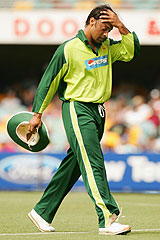Club cricket's international future
Two new tournaments are preparing for their first airing this week
Andrew Miller
02-Aug-2005
|
|

|
It concentrates the mind when the two oldest and most privileged Test nations also happen to be the two best. To all intents and purposes - and notwithstanding anything that might happen at Edgbaston later this week - 2005 is the year in which Ashes cricket finally reclaimed its place as the ultimate contest in the game. The flip side of this happy homecoming is that one cannot help but notice the paucity of what lies beneath.
From Project USA to the Caribbean contracts crisis, via Zimbabwe's rebels and Kenya's corruption, 2005 is already shaping up to be a watershed year for international cricket. An us-and-them feeling has been pervading the game, not least when Bangladesh, one of the few teams outside England and Australia who can legitimately claim to have had a good year, were being routed in their early-season Test series.
Never mind adopting a two-tier system for Test cricket. On the evidence of the recent Lord's Test, England are the second tier. It is the third, fourth, fifth and sixth tiers that are the real concern. The recent ICC Trophy did its bit to boost the grassroots of the game, with the promise of ODI status and ICC funding for the successful few, but as Neil Drysdale reported last week, the rewards for winning do not remotely match the costs of living up to the expectations of a newly-professional team. Funds are the bottom line. It was ever thus.
To that end, two new tournaments are preparing for their first airing this week. Both have attracted their fair share of scepticism, both promise to deliver some of the finest players in the world to a new untapped audience, and both have an unashamedly capitalist agenda. Only one, however, would appear to have cricket's best interests at heart.
The squads for the inaugural Afro-Asia Cup were unveiled on Monday, and they said everything about the imbalance of power in two of cricket's most targetable regions. No fewer than 13 South Africans have been called up to represent their continent in three one-day internationals, beginning at Centurion on August 17. The numbers have been made up by three Kenyans and three Zimbabweans.
Asia's squad is a more balanced mix of Pakistanis, Indians and Sri Lankans, but regardless of their shock win against Australia, there is just one Bangladeshi in the 15 - Mohammad Ashraful - albeit with two more waiting in the wings as reserves. "Singly we are strong, together we are even stronger," said Jagmohan Dalmiya in a lyrical appraisal of the tournament. But as the Lions rugby team would testify, there is no substitute for day-in, day-out gelling with the same set of team-mates.
It's billed as a showcase, but this is just another numbing one-day international tournament to add to the treadmill, and this time it will lack even the competitive edge and cohesion of a nation-versus-nation tussle. Throw in the confusion of the new substitutes rule for one-day cricket and it is even less appetising, relying on the same jaded faces - Shoaib Akhtar, Jacques Kallis, Shaun Pollock - to flog another repackaged version of the same old event.
The stated aim of the Afro-Asia Cup is worthy enough, to "boost activity and support for youth and junior cricket across Africa and Asia", but when it comes to reaching those parts that conventional international cricket cannot address, the tournament will have all the lasting impact of a Live8 concert. And that's assuming that Dalmiya really is Bob Geldof in disguise.
The other tournament in the pipeline might yet be of interest to the citizens of Garabone, Kampala and anyone else unfortunate enough to have been born outside cricket's limited scope. The inaugural International 20:20 Club Championship takes place at Grace Road in September and has grand designs on becoming cricket's answer to the Champions League.
There are many hoops to be jumped through yet, and the format could fall flat on its face like that short-lived Zone 6 City Cricket experiment of the early 2000s, but for the first time in cricket's history, a form of the game has been hit upon that is popular and accessible and egalitarian. Over 20 overs, no team, international or otherwise, need believe that any opposition is too good for them, and so at a stroke, all the problems that have bedevilled cricket's forays into foreign markets are solved.
That might, of course, mean that the game is too much of a lottery at the highest level, as Ricky Ponting and Michael Vaughan were both keen to stress after that extraordinary Twenty20 international at the Rose Bowl in June, but at the intermediate level, it works wonderfully as a spectacle.
On Saturday, for instance, Somerset's 23-year-old wicketkeeper, Carl Gazzard, became an instant legend in front of a packed house at The Oval, as he first belted his side to a defendable total in the second semi-final, then pulled off a match-turning pick-up-and-throw to run out Jeremy Snape. In Twenty20 cricket, the action drives the contest, like a sharply directed arthouse film in contrast to the lumbering big-budget A-list love-in that is the Afro-Asia Cup. There is reason to believe it can succeed where other innovations have sunk without trace.
Andrew Miller is UK editor of Cricinfo

